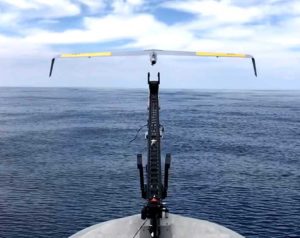Elbit Systems has added an Unmanned Aerial System capability to the Seagull Unmanned Surface Vessel (USV), broadening surveillance and intelligence gathering capabilities of the unmanned boat. Trials conducted in recent weeks were dedicated to the integration of Elbit Systems’ Skylark C mini-Unmanned Aerial System (UAS), onboard the Seagull USV, further enhancing its intelligence-gathering capabilities.

The Skylark C is designed for fully autonomous operation, from launch to recovery. The drone is launched automatically by catapult from the USV, and recovers by parachute at a Point Water Recovery (PWR), where it is retrieved by a support vessel. recovery and a takeoff weight of up to 15kg. The drone’s electrical propulsion sustains missions up to five hours, at a ceiling of 15,000 ft, and a range of 40 km from the launch vessel. Upon retrieval, UAVs use ‘hot-swap’ batteries to prepare and continue mission operation. The visual feed generated by the mini-UAS can be transmitted via the SeaGull communications channel to the Combat Management System (CMS) on other vessels, or the land-based command and control unit.
The SeaGull is designed as an autonomous, multi-mission USV for underwater operations, such as Anti-Submarine Warfare (ASW) and Mines Countermeasures (MCM). the USV’s switchable payload suite includes Electronic Warfare and Electro-Optic/Infra-Red payloads to provide situational awareness and facilitate intelligence gathering. The integration of a tactical UAS onboard the USV further expands its capacity to generate intelligence enabling to utilize the USV for enhancing the situational awareness of any maritime force and for shore exploration.
The Seagull USV enables naval forces to enhance performance while reducing risk to human life and dramatically cutting procurement and operating costs. In recent months Elbit Systems has added the HELRAS sonar in-cooperation with the Israeli Navy and concluding a series of trials for the TRAPS-USV towed sonar, significantly enhancing its ASW capabilities.
The Seagull USV is an autonomous multi-mission USV featuring switchable, modular mission payload suites capable of performing ASW, MCM, EW, Maritime Security (MS), Hydrography, and other missions using the same vessel, the mission control system and the same data links. The Seagull USV was deployed by in several exercises that were conducted with NATO maritime forces in the last few years, including in an MCM exercise alongside the HMS Ocean of the UK Royal Navy, and an ASW exercise that was conducted together with the Victoria and the HMS Duncan frigates of the Spanish Navy and the UK Royal Navy.
from Defense Update: https://ift.tt/3ff476H
via Defense News
No comments: